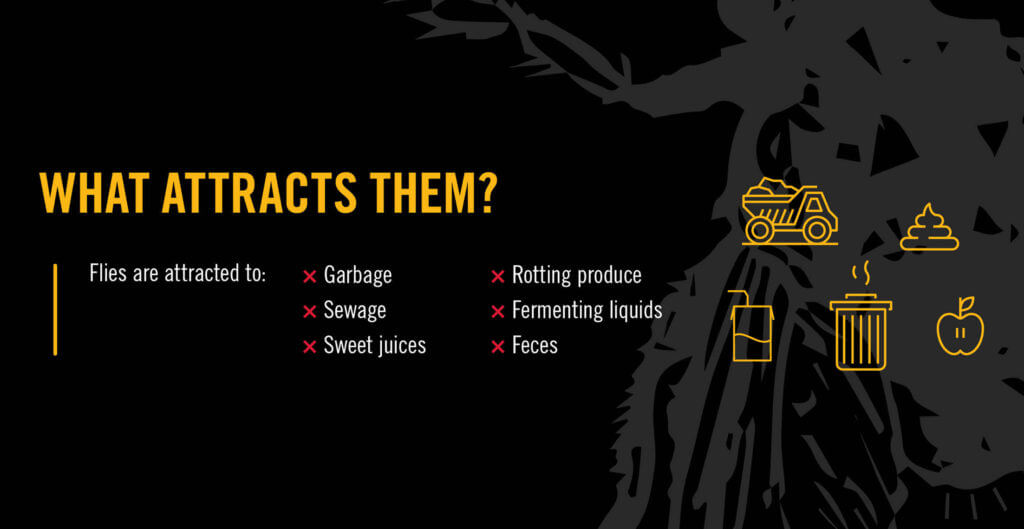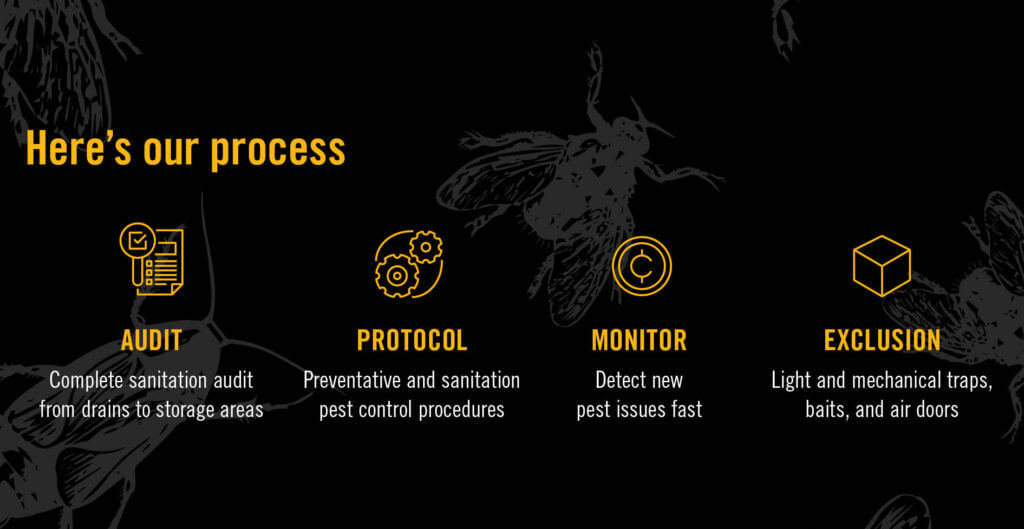Outdoor bar or restaurant areas are being used all year round now.. While guests enjoy happy hour, it’s possible pests will too.
Fermented alcohol, fruit, syrup and soda combined with pungent food odors create the perfect happy hour for pests, especially flies. Plus, standing water, patio drains or spilled liquids provide an ideal breeding ground for flies to multiply.

Flies are more than annoying – they are twice as filthy as cockroaches and carry more disease-causing pathogens. Flies feed on organic waste, thus they collect numerous germs on their legs and mouths. This means, each time one of these flying pests land, they slough off thousands of microbes and bacteria that can contaminate food and surfaces. These nasty pests not only pose a health risk to your guests, but they can undermine your reputation and pose an even bigger risk to your bottom line.
Approximately 200 fly species, categorized as “filth flies,” thrive in human environments including businesses. Here are the types of flies your guests and staff are most likely to encounter:
House flies are one of the most common types of fly. They are also referred to as a garbage fly. House flies often hang out at trash cans so make sure to dispose of trash frequently and keep lids tight. House flies taste with the highly sensitive sensory receptors on their feet, which are 10 million times more sensitive to sugar than the human tongue.
Their egg-laying sites typically involve organic material, like food. They can most easily be identified with four lengthwise stripes on the thorax. They spread microorganisms such as bacteria and viruses on surfaces they land on and are associated with more than 100 pathogens, including Salmonella, Staphylococcus, E. coli and Shigella.
Females may lay a total of five to six batches of 75 to 100 eggs in her lifetime. In warm weather, eggs hatch in 12 to 24 hours. Because house flies reproduce quickly and in large quantities, a small fly issue can get out of hand quickly and create a huge problem for your business.
Fruit flies (or vinegar flies) live off of a diet of sugary, malty or vinegar-type materials. On the smaller size, these 1/8-inch long pests lay their eggs near fruits and vegetables (and other decaying matter). Quick breeders — a female fruit fly may lay up to 500 eggs in her lifetime. They can mature from egg to adult in about a week, so it doesn’t take long for an infestation to transpire. Soft drink dispensers, beer taps, over-ripe fruit or fruit wastes, trash containers or vending machines with product residues are often hot spots. You can find them near fermented materials in trashcans and floor drains.
Gnats are known to be extremely annoying to humans. They are attracted to fruit and sweet scents (perfume, hair spray, lotion, etc.) as well as moisture (sweat, mucus) and body heat, so they often fly into eyes, ears and noses. A potted plant can support all fungus gnat life stages. Gnats have shiny black heads and transparent wings.
Phorid flies are one of the greatest food safety threats because they have the most diverse food source opportunities. They have humped backs, which makes them easy to recognize. They are about a 1/4-inch long and thrive off moisture and breed in decaying matter so they can often be found in the bottom of trash cans, kitchen equipment and backed up drains. Female phorid flies lay up to 750 eggs in their lifetime which can take more than 20 days to become adults.
Drain flies are common invaders. These distinctive and fuzzy little flies might be confused with a moth. Drain flies usually occur in small numbers — typically resting on a wall or surface and only move a few feet when disturbed. They can live up to a month, while surviving dramatic changes in temperature and low-oxygen environments. Drain flies (also called sewer flies) breed in raw sewage under slabs where undetected broken pipes may be located, as they need standing water to breed.
Prevention Tips
It’s best to implement an Integrated Pest Management (IPM) program to help eliminate conditions that attract flies through proactive sanitation and maintenance. IPM is an ongoing process, and it emphasizes a partnership between your pest management provider and your staff. By implementing a strong IPM program and training staff, you’re ensuring your bar is the perfect happy hour for your guests and not unwanted pests.
- Keep food, especially produce, covered and sealed. Sliced fruit, fresh herbs and garnishes that sit on bar tops attract flies. Be sure to keep these items covered and sealed.
- Clean up spills quickly. The same beverages that attract guests, will attract flies when spills occur. Clean spills up immediately. Liquids on the floor create odors and sticky residue, sending the perfect invitation for flies to come join the rooftop party.
- Deep clean surfaces and equipment. Thoroughly wipe down all countertops and chairs in the bar area and remove any food residue at the end of every shift. Be sure to clean out the drain with a bristle brush each day to help remove leftover debris from building up and attracting pests. Also, thoroughly clean all beverage appliances. Equipment such as floor mats, liquid dispensers and speed rails have cracks and crevices where liquid can easily collect. And don’t forget to check the areas underneath equipment where condensation and debris can accumulate.
- Sanitize trash bins. Consider using an organic cleaning solution to sanitize your trash bins and don’t forget to look around the area for any leakage that may collect and attract pests. Remove garbage and spoiled foods from your premises. Another helpful practice is to keep trash bins sealed tightly, when possible, and empty them often.
You may have a fly infestation if you see:
- Clusters of flies near spilled sweets or unsealed liquids.
- Clogged drains, which are fly breeding sites.
- Presence of maggots or larvae.
- Additional pests present like roaches or ants.
If you spot a fly on the wall, reconsider do-it-yourself pest control techniques. A single intruder can quickly create a full-on infestation. Consider contacting a pest control expert to do the dirty work for you! Western Pest Services offers thorough fly pest control — from uncovering infestations and identifying their sources to keeping your business pest free all year. Using IPM practices, we not only get rid of flies — we teach you what steps to take to help ensure that they don’t return.

We know how damaging flies can be to your business. That’s why we offer thorough inspections, a service warranty, unparalleled support and the highest level of customer satisfaction.